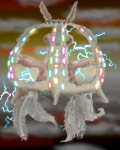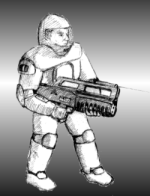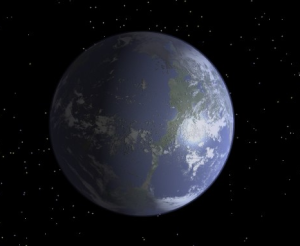This page attempts to introduce the main highlights of my game universe, Spheres. Inevitably, some things are left out; there are more details in ARCADIA, the encyclopedia for Spheres. Otherwise, you may want to go back to the main Spheres page.

Overview
Spheres is set in the year 2221 CE (or AD, if you prefer). Humanity has been able to exceed the lightspeed barrier for approximately 150 years, during which time people have explored, settled and fought over an ever-growing area of space. This space is called Known Space.

The fastest that anyone can travel is about one light-year per day, meaning that, although it has been possible to settle far-flung areas, communication with them has not been easy to maintain. After the initial push to colonize (c. 2070-2110), the colonies soon began to chafe under the distant rule of Earth, and began to desire their own independent states. This happened in a series of wars which began in the 2120's.
Now, Known Space is divided into Spheres, which are autonomous governmental groupings of one or more settled star-systems. They differ widely in their wealth, style of government, power and size. Humanity has also encountered several sentient extraterrestrial species in its travels. Their psychologies have been quite alien to humans, though a couple of these races (the Hammerheads and the Starwhales) have proven to be useful allies to humanity. One of these races, though, the Tripods, was initially so hostile that their contact brought an almost immediate war that threatened the majority of humanity. As of 2221, the Tripod War has only been out of the picture for about six years.
Humanity has made many discoveries along the road to the present, but also had many setbacks. The Artifact still fascinates physicists and sapientologists alike, and the wonders of FTL flight and non-human technology and psychology are fertile ground for more discoveries. On the other hand, the Wall has meant humanity's faith in progress has eroded a great deal, and the recent Tripod War has meant that humanity no longer considers its self-government inviolate.
Most importantly, though, humanity is still humanity. Selfish, arrogant, short-sighted, bickering, but also sometimes beautiful, giving and truly moral, human psychology has changed little. The problems of the 23rd century are very much the same as the problems of the late 20th, just perhaps even more complicated.

Definitions
A few definitions about what all this is may be in order:
Known Space
Known Space is basically the area of the universe which is well-known to humans. Of course, there are other sentient species in the universe, but humanity's knowledge of their universes is decidedly limited. Known Space extends in a rough sphere, approximately fifty light-years in radius from the Solar System. Parts are well-known; others are barely mapped.The Present
The current year in 2221 AD (also commonly written CE).
Spheres
A Sphere can be two things in Known Space. First is an occupational sphere, much the same as the traditional definition of the word would have it. Thus, the law enforcement sphere contains private detectives, police officers, security workers and other related professions.
The second meaning of 'sphere' is a governmental entity that includes several star systems. Some spheres are large (a dozen or more star systems), while others are quite small (even down to two systems; one system alone cannot constitute a sphere). Some spheres are strongly governed, with a single overarching government; others are really little more than confederations.

Species
There are five non-human sentient species in Known Space, at least so far as anyone is aware. None of the species' own names for themselves are pronounceable to humans; thus, the names they have here are all human-invented monikers. A picture showing the six species is available. The species are:
Humanity
If you're reading this, you're almost certainly a human. Humanity in the 23rd century has its differences from that of the late 20th century -- a fair amount of genetic editing has gone on, for example -- but neither century's humans would see the other as alien.
Starwhales
 The Starwhales are aquatic, pentagonally-symmetrical and carbon-based. They average about 4 m. in length, and reproduce via two sexes. Their maw is surrounded by five manipulatory limbs. Their social organization is extremely complex, but still understandable from a human perspective. They communicate primarily via sound, though their vocal ranges are far in excess of humans' on both the high and low ends of the frequency scale.
The Starwhales are aquatic, pentagonally-symmetrical and carbon-based. They average about 4 m. in length, and reproduce via two sexes. Their maw is surrounded by five manipulatory limbs. Their social organization is extremely complex, but still understandable from a human perspective. They communicate primarily via sound, though their vocal ranges are far in excess of humans' on both the high and low ends of the frequency scale.
Starwhale technology is generally at least the equal of humanity's, but their biotechnology is far in advance of the equivalent human tech. In fact, biotech is the Starwhales' primary form of technology; inorganics are somehow disturbing to them. Starwhales date the beginning of civilization not from the invention of agriculture or pottery as humans do, but from the domestication of animals.
The Starwhales are perhaps the extraterrestrial sentients most closely associated with humanity. Primarily in the Islamic Sphere, but also in other spheres adjacent to Starwhale space, the Starwhales actually have established communities and business ties.
Hammerheads

Hammerheads are bilaterally-symmetrical, carbon-based and semi-vertebrate. They average approximately 4 m. in total length, but typically, about half of this is upright while the other half stays in contact with the ground. They have six manipulatory limbs located on the lower thorax. Hammerheads are trisexual. Hammerhead psychology resembles human psychology the most of any extraterrestrial species, but is still difficult for humans to understand.
Hammerhead technology is perhaps slightly behind that of humanity as a whole. As contact was only established a few decades ago, however, few humans have a good sense of what the Hammerheads are capable of.
Opening up Hammerhead markets may eventually push the ISC, who more or less have a monopoly on contact with the Hammerheads, into economic dominance over the ICA or LSN; many investors are certainly banking on it.
Shojin

The shojin resemble the centaurs of Greek mythology; they are bilaterally-symmetrical, with four ambulatory limbs and two manipulatory ones. They are derived from cliff-dwelling stock and are extremely nimble, though not so nimble as their forebears.
Shojin society is at a very primitive technological level compared with that of humanity, perhaps equivalent to early Bronze Age cultures on Earth. Thus, the Shojin societies are still in the process of evolving.
The Islamic Sphere maintains a strict interdiction against any contact with the Shojin. Nonetheless, there is a great deal of accidental or illicit contact with them, and several parties argue for formally introducing the Shojin to humanity before any more accidental damage is done.
Qiqiu

The Qiqiu are perhaps the strangest race of all the sentients in known space. They are airborne, with their bodies consisting largely of a massive (c. 10 m. average diameter) sac containing various buoyant gases. They are quadrilaterally symmetrical, and apparently reproduce by sporing. Qiqiu are also noted for their long lifespans; apparently, most live to at least 500 Terran standard years, but historical records support the existence of examples at least 2000 years old.
Qiqiu psychology is perhaps the most alien of the non-human races. Qiqiu seem to be able to truly "multi-task"; they are able to follow several hundred thought processes simultaneously. Communication is primarily by means of phosphorescent flashes, requiring humans to use holosystems for contact. The rate at which Qiqiu communicate is extremely high, requiring humans to either use a great deal of processing power or to plod along at human speeds. Further, Qiqiu are also able to hold many contradictory points of view simultaneously; determining what a Qiqiu really, permanently thinks about a given topic often takes weeks or years. Qiqiu are starting to recognize and allow for the limitations of human communication, but the process still requires extreme patience for all parties concerned. (One theorist remarked that, for a Qiqiu, talking with humans must be like talking with a creature that can only say one word per year, and doesn't know how to stop a sentence in the middle.)
Qiqiu technology often seems ponderous to humans, but it is actually highly advanced. However, human access to it has been limited, due to the Qiqius' rather reclusive nature.
One unfortunate fact about the Qiqiu is that their brain matter is an exceptional hallucinogenic among humans. Thus, there is a small market for Qiqiu bodies, and even for killing Qiqiu, although human authorities naturally condemn it.
Tripods

Tripods are hexagonally symmetrical, are carbon-based and have broad, chitinous shells, superficially resembling Terran crabs. They have full 360° vision, and have six manipulatory limbs and six ambulatory ones. Their reproduction system is unknown, but is presumed to be sexual. General information on the Tripods is scant, due both to the short time humanity has known about them and to their extreme xenophobia.
Tripod technology, where comparison has been possible, seems generally on a par with that of humanity. Their drive technology seems to be rather better than humanity's; the few captured Tripod ships in Known Space have proven highly instructive in a variety of fields.
On a personal level, the Tripods seem to be peaceful and reclusive, but immediately after being contacted, the Tripods began a ferocious war against humanity in 2205. The war came very close to defeating the combined forces of human space, but eventually, the Tripods simply stopped warring, as mysteriously as they had started. No open warfare has occurred with the Tripods since 2215.

History
Of course, the history of Known Space up to the present (2221) has been full of various trends and currents, many often contradictory. Summarizing the events which have lead to the modern world is difficult, so the reader will please forgive this writer if she does a rather poor job of it. For a more complete version, please see the document solely concerned with the history of Known Space.
Corporatization
One of the main trends in history has been corporatization. Corporations assumed increasing power throughout the 20th and 21st centuries, and began to feel they were represented less and less well by the traditional nationstate model. Thus, the 21st century is called by some the Corporate Century, in which the Corps (as they are now called) came into their own. Many tried to eliminate the nationstate model altogether, but the successful majority grafted themselves onto the old model and improved upon it (at least from their standpoints). Thus, by the end of the 21st century, many corps dealt with other governments on an equal footing, and were subject to none but their own laws. Citizenship issues were, and continue to be, difficult. In addition, some traditional nationstates have replaced their traditional governments with more corporate models.
Erosion of the nationstate

Going along with the trend towards corporatization has been the gradual erosion of the nationstate as the primary form of human government. Although the majority of humanity still lives under a traditional nationstate, the percentage seems to be on a gradual but definite downturn. Nationstates' abilities to meet the obligations implied by their nationalisms have been a major cause of this downturn, but the competition of corporate states and other alternatives have heightened the effect considerably. In addition, or perhaps because of this, nationalism has come to be seen as rather provincial or backwards; while many people still fight for their national pride, many see this as childish. (Of course, these same people may fight equally hard for a corporate mission statement, or other such creed.)
Finally, many of the nationstates that existed in, for example, the late 20th century have broken up, due largely to the collapse of nationalism as a unifying element. Examples of these breakups have included most of the larger nationstates: the USA, USSR, China, India, Italy, Brazil (to an extent) and numerous smaller ones. In addition, most of early attempts at forming international organizations failed: witness the UN, European Union and Mercosur. However, there appears to be a new generation of multilateral or multinational inclusive elements, such as the unification of several Middle Eastern nations, or the LSN itself. The future of the nationstate is unclear.
Spaceflight
Another of history's main trends has been the increasing practicality of flight to the stars. The completion of the Major Unification Theory, and the Karlan-DaRosa faster-than-light drive which derived from it, have meant that humanity is ever more free to roam the universe, exploiting and exploring. Colonization, which primarily resulted first from national pride and then from overpopulation on Earth, has slowed in recent decades. Some point to the recent Tripod War as the cause for this; others believe it is because the original impracticalities inherent in space colonization are becoming apparent; others believe it is because humanity's ability to communicate over such vast distances is degrading to the point where humanity no longer constitutes anything resembling a civilization, and is currently in a coalescing phase. A major result of humanity's spread into communicative distancing has been the rise of various new star-nations, or spheres. These spheres have been rebelling primarily against the original colonial powers of the Earth, though now a third-generation ring appears to be forming from colonies rebelling against their own rebel governments.
Uncertainty in progress
Another trend has been the increasing uncertainty of many things which people of the 20th century often took for granted. Foremost here is scientific progress. First, with the Little Wall of the 2020's, then with the Wall of the early to middle 2100's, science's ability to push on has come into severe doubt. Most people now barely remember the Wall, if at all, but still, there's a great deal more cynicism about technology than there was in the late 20th century. Also coming into doubt is the ability of the traditional nationstate to provide in any efficient way for its people; even the comfortable laxness most privileged people have traditionally felt with regard to their domestic safety has come under fire, almost literally, as the Tripods came within only a little more than a dozen light-years of Earth.

Spheres
Known Space is composed of Spheres. A Sphere is basically a collection of star systems which share a common governmental body, though many barely have intrasystem governments, much less intersystem ones. The Spheres in Known Space, along with descriptions of them, are listed below. A rough map of the systems and spheres of Known Space is available.League of Sovereign Nations
The LSN is the primary Sphere in Known Space. It is the home of the majority of the human race, as well as the location of humanity's home, Earth. It contains the following systems:-
Sol
This is the center of humanity, both in terms of population and in terms of history, though many would debate its importance in terms of economics. Fully 11 billion people live in the system, and most worlds which can be populated are.
-
Centauri
This was one of the first systems settled, but it pales in comparison to Barnard's, due to its lack of any easily-habitable worlds. It does rival Barnard's in terms of strategic importance, though, and is home to the LSN's second-biggest fleet of starships.
-
Escalante
One of the backwaters of the LSN, Escalante is known as a center of reseach but little else.
-
Barnard's
This is the second-most important system of the LSN. Its planet Nova Siberia was a major focus of early colonization efforts.
-
Wolf
Another of the backwaters of the LSN, Wolf has been fought over from time to time by the LSN, the Mahabharati Empire and the Yan Empire.
-
Salvador
Salvador's main distinction is that it is the main point of LSN contact with the Qiqiu.
-
Mendoza
Mendoza competes with Salvador for trade with the Qiqiu, but it is generally a backwater of the LSN.
The LSN was formed in 2060 by a group of corporations (along with their nationstate patrons) who had long chafed at the control asserted over them by nations which they no longer felt a part of. The LSN's extremely economical style of government proved to outlast its main rival (the UN), and eventually the LSN evolved into the main governmental entity of the Earth.
As humanity began to expand out into the Void, its colonization efforts were guided by the LSN. At first, it was the member nations and not the LSN which guided the process, but the expansion meant that mere states weren't equipped to deal with the expansion. Thus, the LSN took on more and more direct responsibility for colonization.
However, the governmental system eventually expanded beyond its ability to communicate efficiently. This meant that whole populations were being ruled by officials who lacked either the resources or the rank to make effective decisions. Thus, the colonies eventually rebelled, causing the Colony Wars. Out of these, the LSN grew smaller and a little more efficient, while many of its colonies became independent spheres in their own right. The LSN of 2221 is a very inward-looking and uncertain version of its former self. Nonetheless, LSN victories in the Tripod War have given the LSN leadership adequate reassurance that their government is capable of leading the way into the future.
Interstellar Commerce Alliance
The ICA is the main rival of the LSN for the title of most important sphere in Known Space. Its major system, Petit-Sol, has the single greatest concentration of humans outside the Solar System. The ICA contains the following systems:
-
Sirius
Sirius has been fought over many times in past, largely by the LSN and ICA, and for a short time (2124-2139) it was even an independent republic. Many Sirians would like to see their system become a republic again.
-
Luyten
Luyten is probably the second-most important system in the ICA. It is well-placed for trade between the ICA, LSN and Islamic Sphere, and has a strange atmosphere which is exotic, sophisticated and cosmopolitan all at once.
-
Petit-Sol

Besides Sol, this system is probably the most important one in Known Space. It is a center of population, fashion, government, military forces and not least finance for a large part of humanity. The main planet, Petit-Terre, is one of the few Earthlike planets found to date, and many people dream of experiencing not the open spaces of Earth (which are mostly crowded and polluted anyway), but of dancing in the fields of Petit-Sol.
-
Kapteyn's
Kapteyn's is something of a backwater. It is a center of manufacturing and mining, but serves primarily as a strategic link between Sirius and the rest of the ICA.
-
Freehaven
Freehaven was never a terribly important system, and its near-devastation during the Tripod War has meant that it is once again clawing its way to prosperity.
-
Tetsuyama
Tetsuyama rivalled Luyten for importance for a long time, until the Tripod War. The Tripods attacked Tetsuyama with a rutthlessness rarely experienced in human history. Tetsuyama's once-grand tourism industry is starting to pick up, but many tourists are scared of coming so close to Tripod space, and stories abound of Tripod warbots or worse being found.
The ICA is basically run as a corporate consortium, with various corps taking out contracts to provide specific governmental services to the central government. The central government itself is elected by the populace, though different corps have different voting schemes. The central government is responsible for intelligence, law and a core of telecommunications services, as well as a control body which is responsible for determining monetary policy and keeping a light watch on trade. All other functions, and a wide variety of functions within those already described, are provided by vendors who are contracted for specific periods of time. Competition is usually quite fierce, though corruption does of course exist.
Independent Systems' Confederation
Formed after a relatively bloodless coup in 2133, the ISC is a broad mix of contradictions: sly entrepreneurs alongside corrupt bureaucrats, brave privateers next to mild-mannered desk-workers, cynical bounty-hunters alongside starry-eyed reformers. It often feels like the best of humanity, but usually tends to reflect what is basest is us. Its government, what little there is of it, rules over the systems of:
-
Fuxing
Fuxing is the oldest of the ISC systems, and shows its age. Infighting among corps has meant that many of its stations are in poor repair, and abandoned hulks litter the system. Piracy is also rampant in the outer system, although periodic government sweeps manage to get rid of the worst offenders.
-
New Sacramento
This is the main system of the ISC, and the one where corruption seems to be held best at bay.
-
Penglai
Penglai is one of the most important conduits between human space and Hammerhead space. It is perhaps the center of the ISC's entrepreneurial spirit; many of the ISC's newest companies have their HQ's here.
-
New Ohio
New Ohio shares more than a passing resemblance to its namesake: it is industrial, neither densely populated nor sparsely populated, independent-minded and not a little polluted. Many hold it up as an example of the worst excesses of the ISC system.
-
Spectre
Spectre is one of the newest systems of the ISC (settlement began only about 80 years ago), even though it actually lies quite close to LSN space. This is because it as a relative dearth of resources, and colonization was not deemed practical until recently.
The ISC works like a more corrupt version of the ICA. Instead of taking specific service contracts for finite periods, ISC corps gain control of whole settlements, even planets, which they govern as they see fit. Thus, horizontal monopolies are the rule in the ISC. The federal ISC government is almost powerless when compared with the various elements which supposedly make it up.
Islamic Sphere
The Islamic Sphere comprises four systems, all united loosely in a religious-economic framework. The systems of the Islamic Sphere are:-
Jayapura
Jayapura is the oldest of the Islamic Sphere's systems, and shows it -- although Babylon is the main center of Islamic Sphere population, Jayapura is the center of Islamic Sphere culture and education.
-
Malacca
Malacca is something of an also-ran when compared with either Jayapura or Babylon. Although it is a major center for trade, its character is not nearly so strong as the other systems in the Islamic Sphere.
-
Babylon
Babylon is the most densely-populated system in the Islamic Sphere, due to its prize planet, Ur. Ur is one of the few garden planets discovered in Known Space, and is still one of the least densely-crowded. Ur is further distinguished by the fact that it is the home of the Shojin, a sapient species which has not yet reached the Iron Age.
-
The Artifact
Babylon is also a very short distance from the Artifact, a very strange object indeed. A small sphere (20 cm or so in diameter), it radiates vast amounts of energy on all frequencies with no apparent energy source. It is presumed to be the work of some sort of advanced intelligence, but its makers' identity and intentions remain a mystery. Some also believe it is the reason why the Tripods stayed far from Babylon during the Tripod War, even though Babylon is closer to their space than many of the systems which they ravaged.
-
Ibrahim
Ibrahim was colonized relatively recently -- only in the 2150's -- and many are still waiting to see whether it will be a boon or a bust for the Islamic Sphere. Of all the systems in the Islamic Sphere, it is probably the most wild and rowdy.
The Islamic Sphere (usually not abbreviated) was the first non-LSN Human sphere formed, in 2124 (though it did not take on its modern name until much later). It is quite an unusual sphere: it contains Babylon, home of the Shojin and one of the few garden worlds in Known Space; it is where the mysterious Artifact is found; and it is by far the most successful example of human-alien integration.
Last but not least, it is also a strongly religious society. The dominant religion is a form of liberal Sunni Islam, but almost all religions (including atheism) are tolerated. Although the government itself is nominally secular, appointed officials tend to listen to religious scholars' advice very attentively. Government sponsorship of learning is quite strong in the Islamic Sphere; a disproportionate number of the best universities in Known Space are located there.
Mahabharati Empire
An empire really only in name, Mahabharat (named for India) contains the systems of Nuevo Colombia, Indra, Gandhi and Siva. It was originally formed by an LSN fleet admiral who decided he had had enough of democracy and receiving orders already months out of date. He therefore decided to install himself as Emperor. After his passing, the Mahabharati Empire has taken on a much kinder aspect, but it is still governed by one of the most volatile governments in Known Space; the Mahabharati Empire has gone to war numerous times against numerous other spheres.
Sapient Peoples' Republic
Formed originally as a rebellion against the Mahabharati Empire's strong rulership, the SPR consists of the systems of Egality and Liberty. Egality is the location of one of Known Space's few garden worlds, Eden. The SPR maintains nominally socialist principles, although frequent warfare against Mahabharati forces means that their resources are limited.
Yan Empire
Another of the so-called "Admirals' Empires," the Yan Empire was formed by an ex-LSN fleet commander who had visions of glory. His smallish empire, consisting of the systems of Fuyuan, Zhongwu and Yan, is prosperous (while power-hungry, the Emperor is not foolish) but is of small consequence in the grand scheme of things. Yan is noted as a center of enterprise, whether licit or illicit.
High Kingdom
The High Kingdom holds within its expanse the systems of Haagen, Bayeux and Victory. It is another of the several spheres which were founded by fleet admirals. In the case of the High Kingdom, they formed a fairly benign dictatorship, in which each system's ruler (either the King or a Grand Duke) resides over a small network of nobles, but in which the main part of governing is handled by a highly skilled bureaucracy.
Back Stretch
One of the two newest spheres, and also one of the least-integrated, the Back Stretch contains three systems: Novy Kiev, Tashkent and Caspia. It provides an alternate route between the ISC and Islamic Spheres to those who wish to avoid the LSN and have adequate fuel. Its government is loose at best; most settlements are governed in at least a semi-democratic form, but higher-level organization is sparse and often autocratic. Many sections of the Back Stretch simply have no law save that of the gun.
Corridor
The systems which constitute Corridor are Chihai and Dardanelles. Corridor was once seen as a being the route for future access of the systems lying "below" (-Z) the then-known spheres. Finding the pristine garden world of Constantinople promised much; the discovery of the Tripods and their subsequent war against humanity all but destroyed the dream, however. Government in Chihai is still slowly recovering; Dardanelles' few human settlers are barely holding on to survival. Corridor's governments are understandably un-integrated.
Qiqiu Space
Qiqiu space is naturally controlled mainly by the Qiqiu. Relatively few humans have taken up residence there, though quite a few successful corps do business with the Qiqiu. Human names for the Qiqiu systems which they are concerned with include Montgolfier, New Singapore, Terra Infirma and Oz.
Starwhale Space
Starwhale space is closely integrated with human space, and the Starwhales are quite accepting of humans. Some areas of their sphere remain strangely inviolate, though; no humans are allowed access, and no explanation is given. Humans live in the Starwhale systems of Fez, Hejaz, Ormuz, Ishtar, Astrocetia (the Starwhale home system), Fomalhaut and Locus.
Hammerhead Space
Recently contacted, the Hammerheads seem likely to become fast friends of humanity. Their systems of Daikoku, Thor, Anvil and Hammerhome (their home system) are still opening up.
Tripod Space
Little is known of Tripod Space; only a few humans have ever ventured into it. Humans are primarily concerned with the nearest of their systems, namely Cerberus, from which their attacks poured.

Technology
In many ways, the technology of the 23rd century would be disappointing to a visitor from the late 20th. There is no time travel (sadly making such a visitor an exceeding unlikelihood), no instantaneous matter transportation, no black hole guns. Stable artificial intelligence has never been achieved by humanity (though hints indicate that it has been achieved by the Starwhales), and the precise mass of the Galaxy remains a mystery. The most common weapons are still powder-based slugthrowers, and nanotech has proven to be more of a bust than a boon. Communication is still by encoded EM radiation (often even radio, though lasers and other tightbeams are a close second). Infotech of the 23rd century, while quite advanced, is simply greater by an order of magnitude or so rather than being in the realm of dreams.

However, many achievements have been made. Most notable is the Anne Karlan-Julio DaRosa-Effect Drive, or K-D Drive for short, which has allowed humanity to move at speeds of up to one light-year per day, and which has thus opened the universe up to human exploration. Biotech has achieved amazing things for humanity, including lengthening the average life span to about 130, making perpetually-renewable high-efficiency fuels and allowing the definition of 'humanity' to be bent sometimes to the breaking point with cloning, personality-distribution and cryogenics. Advances seem likely to continue into the foreseeable future, though at what rate few can even guess.

Society
The far-flung nature of humanity in the 2220's means that humanity has far less cohesiveness than it did in the late 20th century. Although infotech allows one to communicate virtually instantly with someone on the same planet, giving whatever information is necessary, communicating with someone several light-years away can often require weeks if not months for each person to speak. This has meant that governments are limited in size to their ability to transmit messages; the largest governments are those which are able to communicate the fastest. English is, for the most part, the most common language in Known Space, but different systems' versions of it are diverging rapidly, and accents are quickly becoming separate dialects. Thus, interstellar society is balkanized, with a variety of different spheres and other interstellar bodies competing for influence.
On a local level, though, life is fairly similar to the 20th century version of it. People still work, there are still stresses to be dealt with, children still grow up, people still die and mourn. Work for most people means a combination of full-time and on-call duties, usually to a single employer but not always. Manufacturing is almost never done by humans in developed areas; the majority of people engage in services almost exclusively. People generally work in their own offices at home, but then, nearly a majority of humanity lives and works on company property anyway.

Privacy is something that people in the far-off colonies take for granted, but which others can usually only achieve through simulation. In the developed worlds, people live most of their lives under one form of surveillance or another. Computer agents automatically record any malfeasance; everything else is deleted, or so the governments say. Privacy commissions deal with requests for personal information from the police, and they usually do ensure people's privacy, but no system is perfect. A common response to those who long for personal space is, "Go to Corridor! You'll find lots of space -- and Tripods waiting for you."
Families still exist and are a strong part of most people's lives, but bonds tend to be less strong. Marriage, while retaining its romantic luster, has become a very temporary thing, save in a few conservative areas. Love has retained its complexity, as has sex; both have become simultaneously more ideal and more pragmatic with the passing of time. Parenthood of many sorts, rather than the traditional mother and father, have become possible through medical technology. Examples include people who bear children as one sex but then procreate again as another. Few people choose to avail themselves of such experiences, however. One major difference with the 20th century, though, is that almost all people choose their own mates; Western-style romance and love, along with the attendant concepts about choosing one's mates, have become the norm throughout the world.
Fun and entertainment vary greatly depending upon where one is; in the colonies, it may consist of hiking some desolate mountain, then pitching a pressure tent and having a picnic at the summit. In central areas, though, relaxation may be limited to simulations or other indoor activities, such as attending a salon or going to a live concert. In any case, real experience, though often hard to tell from simulated experience, is still considered superior to the ersatz variety. Many people actually have no time which they specifically designate as "fun"; their work, family and other aspects of their lives are joined into a single whole, where work is a sort of play but play is also productive.

